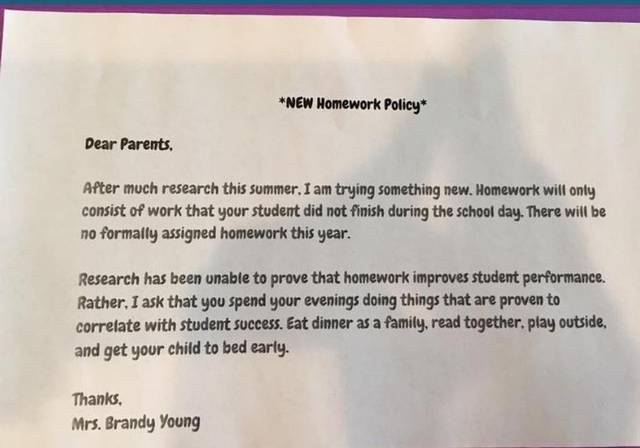
You may have seen the “no homework” letter I wrote last week. It ended up being shared quickly by thousands around the world when Samantha Gallagher, the parent of one of my students, put it on Facebook. My only intention in writing it was to explain ― to the 21 parents in my class ― that I would no longer assign nightly homework to my second graders, and to explain why I thought it was in the best interests of their children. I had no intention of sparking a worldwide conversation. But I’m grateful I did.
Why? Because that little note is drawing attention to an absolutely critical topic: How can we extend learning from the classroom to the home? What can parents do to support what happens in the classroom? And why does it matter? The “No Homework Letter” is about connecting parents to the learning in our classroom. It’s about building community and creating opportunities for parents to learn right along with us!
As a second grade teacher and mother in Texas, I have seen the power that connecting home and school can have on both sides. When teachers and parents work as a team, students win. Frequent teacher-family communication has been shown to increase class participation by nearly 50 percent. It also has also led to students paying closer attention in class.
But building bridges between parents and teachers isn’t always easy. Years ago, as a fourth grade teacher, I sought parents out at community events, little league, and high school football games. I knew the value of having a solid parent-teacher relationship, but I needed a way to break down the barrier and establish an open-door policy that the families trusted.
Since “No Homework” went viral, a question I keep getting is: “How are parents supposed to know what’s happening in the classroom if you don’t send homework?” For me, the simplest way I’ve found to make these connections is through technology ― in my case an app called ClassDojo. ClassDojo makes it easy to break down those walls between home and school in ways that are intuitive for parents, easy for teachers, and fun for students.
On “Meet the Teacher” night I ask my parents to sign up for the app and then I start the year off by reaching out to parents immediately, letting them know that if we work together we can do more for their child. Reassuring them that I will be their child’s biggest supporter at all times.
During the day, I can quickly send a picture when their child is presenting or when they accomplish a new skill. It takes all of five seconds and what I hear from parents is one picture can open up the door to hours of conversation at home. Similarly, with messaging I can share their child’s struggles and suggestions for support. All of a sudden you are a team, working together.
In smaller ways, messaging has saved many children from things as small as shoe blisters and overdrawn lunch accounts, to last minute confusion on whether their parent is picking them up or if they’re riding the bus. Instead of having to go through the front office and leave messages, they can go instantly and directly to me: the adult who is not only responsible, but with, their child.
My students also love being able to use it to upload their own work into a free, digital portfolio that is shared with their parents. They have a real audience for their learning and it motivates them and allows them to reflect on how they’ve grown throughout the year. It really puts them at the center of their own learning.
Bridging the school-home divide is particularly important in schools that are transforming classrooms with project based learning ― where we’re helping students solve relevant problems and answer open-ended questions. It’s about moving beyond a packet of “work” to a continuum of learning that encourages students to engage with parents as they explore new and increasingly complex topics. It encourages students to be active learners, and continue learning outside of the classroom. But for that, parents and teachers need to work as a team.
In our classroom, we’ve also been using ClassDojo to share “big ideas” ― like the concept of growth mindset ― with both students and parents. Because shifting the way kids think about not just “what” but “how” they learn requires buy-in, support, and reinforcement at home as well. The first time I had a student finish another child’s sentence with: “Yet. You can’t do that…yet.” I knew we were on to something. Now, it’s commonplace and the word “yet” is plastered all over the small group table area where lessons are strictly differentiated and the children are most challenged. “Yet” reminds them of the power of their brain, and the classroom support system they have backing them up.
The sort of communication and transparency that technology now allows are why parents like Samantha Gallagher give me their trust. They understand that I believe in what I am doing; and they appreciate the transparency. There is nothing separating them from their child in my classroom. They can view measurable progress through the digital portfolio, and they are kept in the loop on their child’s education.
Trust and communication are what enabled me to explain to parents that no homework doesn’t mean no work. It’s why they believed in the potential for a more personal learning experience. It’s why they are opening their homes ― and minds ― to extend the learning experience.
At its core, that’s what “No Homework” is about. It’s about making it possible for kids to take what they’re learning in the classroom and use it at home. But most of all, it’s about ensuring our kids are surrounded by positive support and encouragement in every aspect of their lives. As teachers and parents, isn’t that what we should aim for?
